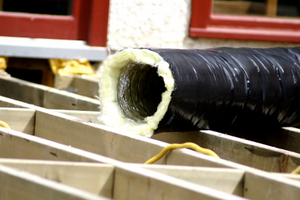Insulating ductwork in your home is one do-it-yourself project that will likely pay for itself quickly. According to the U.S. Department of Energy, uninsulated ductwork in unconditioned spaces in the home causes 10-30% of the heat and cooling to be lost through conduction.
Deciding Which Ductwork Needs Insulating
Air ducts in conditioned spaces in your home lose minimal heating and cooling because they are surrounded by conditioned room temperature air. While this ductwork does not require insulation for protection against conductive heat loss, insulation will prevent condensation and will help ensure that the heating and cooling delivered from the duct is at the proper temperature.
Air ducts in unconditioned spaces require insulation to prevent conductive heat loss.
Airducts constructed from Flexduct or Ductboard are self-insulated and do not require any additional insular wrap.
Choosing Insulation for Your Ductwork
Fiberglass and reflective foil insulation are the most common types of ductwork insulation used for residential applications.
When choosing an insulation for metal ductwork, look for one with a vapor retarder. A vapor retarder prevents the spread of condensation to adjacent walls and protects the insulation itself from vapor damage.
Fiberglass insulation is an excellent choice for stopping conductive and convective heat loss. However, it is vulnerable to mold growth, so fiberglass insulation is not an optimal choice for areas exposed to moisture. When choosing a fiberglass insulation, look for one certified by Greenguard as a low emitter of fibers during the installation process.
Reflective foil insulation excels at preventing radiant heat transfer. It is the optimal choice for certain areas where fiberglass insulation is contraindicated such as crawl spaces, concrete areas and underneath carpet. However, be sure not to use a double-reflective-sided product with concrete as a chemical reaction can damage the foil insulation if concrete contacts the reflective side.
Combining fiberglass and reflective foil insulations may maximize energy savings.
Choose the appropriate R-value for your climate. For warm climates, use R-4 to R-8 in attics and up to R-4 in unconditioned basements or crawl spaces; for mixed climates (moderate heating/cooling requirements), use R-4 to R-8 in attics and R-2 to R-8 in unconditioned basements or crawl spaces; and for cold climates, choose R-6 to R-11 for attics and R-2 to R-11 for unconditioned basements and crawl spaces.
Installing Ductwork Insulation
The first step in insulating ductwork is to ensure that all points on the duct run are sealed. If not already sealed, use a mastic product to seal them. Do not substitute duct tape for mastic because it will degrade over time.
Next, wrap the ductwork with insulation. With fiberglass insulation, the fiberglass side faces the ductwork. When wrapping the ductwork with insulation, cut the insulation sheets to fit the space and attach them to one another using a staple gun.
Reflective foil insulation is attached in the same way. In many applications, the foil insulation will be reflective on both sides; in concrete areas, use one-reflective side foil and face the reflective side inward.
Sources:
http://www.bhg.com/home-improvement/remodeling/energy-efficient/insulating-ductwork-and-pipes/;
http://www.bobvila.com/HowTo_Library/Insulating_Ducts_for_Efficiency-Insulation-A1780.html;
http://www.energysavers.gov/your_home/insulation_airsealing/index.cfm/mytopic=11500;
http://www.house-energy.com/Insulation/Ducts-Insulation.htm; http://www.insulationstop.com/our_thoughts.php;
http://www.inspect-ny.com/sickhouse/FiberglassMold.htm; http://www.greenhomeguide.com/index.php/knowhow/entry/784/C236;




